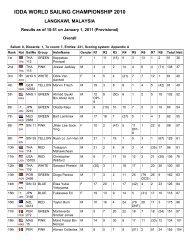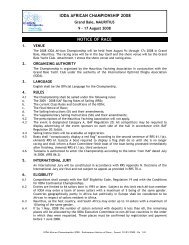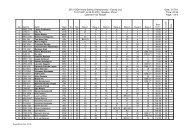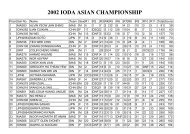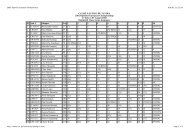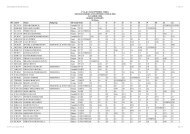2011 INTERNATIONAL OPTIMIST CLASS RULES
2011 INTERNATIONAL OPTIMIST CLASS RULES
2011 INTERNATIONAL OPTIMIST CLASS RULES
You also want an ePaper? Increase the reach of your titles
YUMPU automatically turns print PDFs into web optimized ePapers that Google loves.
3.5.2.7 Distinctively coloured bands, clearly visible while racing, and each not less than 10 mm<br />
wide shall be marked on the mast as follows:<br />
(a) Band No. 1, the lower edge of which shall be not less than 610 mm from the top<br />
of the mast.<br />
(b) Band No. 2, the upper edge of which shall be not more than 635 mm from the top<br />
of the mast.<br />
The lower edge of Band No. 1 and the upper edge of Band No. 2 shall be permanently<br />
marked by a scribed line or not less than two marks made with a centre punch.<br />
3.5.2.8 The mast shall be positioned in the mast step by means of wedges, blocks or other<br />
devices so that it shall be unable to move more than 3 mm in any horizontal direction.<br />
The position of the heel of the mast shall not be varied while racing.<br />
3.5.2.9 The mast shall have a cleat in a suitable position for securing the boom downhaul.<br />
3.5.2.10 The mast shall have, in a suitable position, for the sprit, either a cleat and one hole or<br />
eye (which need not be permanently fixed), or a toothed rack.<br />
3.5.2.11 A locking device or other arrangement shall be fitted and used to prevent the mast from<br />
coming out of its step when the boat is capsized.<br />
3.5.2.12 A wind indicator may be fitted to the top of the mast. The mast may have a fitting (which<br />
need not be permanently fixed) for securing the wind indicator. Such a fitting shall be<br />
positioned within 150 mm below the top end of the mast and it shall have no sharp projections.<br />
The wind indicator or its attachment fittings may be used to help secure the lacing<br />
lines from the throat of the sail.<br />
3.5.2.13 The mast may have a pin stop positioned on the forward side of the mast 1680 mm +/-<br />
10 mm below the top end of the mast. This pin shall not be more than 8 mm diameter<br />
and within 10 mm of the surface of the mast and shall have no sharp projections.<br />
3.5.3 Boom<br />
3.5.3.1 The boom shall be approximately circular and of uniform section throughout. The diameter<br />
shall be not less than 29.5mm and not more than 55.5mm and at any section it shall<br />
not vary by more than 1mm.<br />
3.5.3.2 The boom, excluding the boom jaws, shall not exceed 2057 mm in length.<br />
3.5.3.3 The type of boom jaws and jaws fitting is optional but thickness of the jaws shall not<br />
exceed 35 mm and the length of the jaws fittings shall not exceed 100 mm. A rope may<br />
be fastened to the boom jaws or jaws fittings through two holes or through two eyes, and<br />
pass forward, around and over a pin positioned on the forward surface of the mast (See<br />
also CR 3.5.2.13).<br />
3.5.3.4 A distinctively coloured band, clearly visible while racing, and not less than 10 mm wide<br />
shall be marked on the boom with its forward edge not more than 2000 mm from the aft<br />
edge of the mast. The inner edge of the band shall be permanently marked by a scribed<br />
line or not less than two marks made with a centre punch. The coloured band at the outboard<br />
end of the boom may be on a permanently fixed end cap, provided that no visible<br />
part of the end cap extends inward of the position of the forward edge of the band, and<br />
that the cap complies with the former part of this rule, and with class rule 3.5.3.2.<br />
3.5.3.5 Either the boom or the end cap shall have a hole or lacing eye. The forward edge of the<br />
hole or the opening of the eye shall be not more than 40 mm from the inner edge of the<br />
band at the outboard end of the boom.<br />
20



